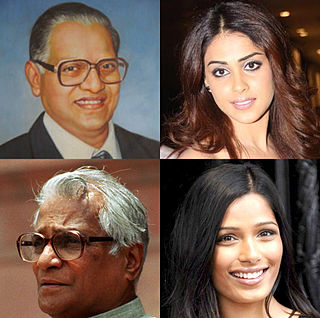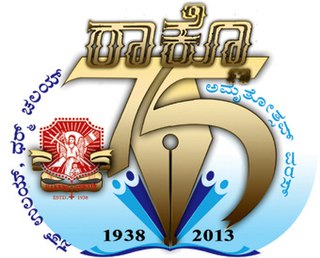
Konkani is an Indo-Aryan language spoken by the Konkani people, primarily along the western coastal region (Konkan) of India. It is one of the 22 Scheduled languages mentioned in the 8th schedule of the Indian Constitution and the official language of the Indian state of Goa. The first Konkani inscription is dated 1187 A.D. It is a minority language in Karnataka, Maharashtra, Kerala, Gujarat and Dadra and Nagar Haveli and Daman and Diu.

Mangalorean Catholics are an ethno-religious community of Indian Catholics adhering to the Latin Rites of worship, from the Mangalore diocese by the southwestern coast of Carnataca. They are Konkani people and speak the Konkani language.
Goan Catholics are an ethno-religious community of Indian Christians following the Latin Rite of worship, from the Goa state in the Konkan region along India's west coast. They are mostly Konkani people and speak the Konkani language.
Roman Catholic Brahmin, is a caste among the Goan, Bombay East Indian and Mangalorean Catholics who are patrilineal descendants of Konkani Brahmin converts to the Latin Church in India, in parts of the Konkan region that were annexed into the Portuguese East Indies, with the capital at Velha Goa. They retain some of the ethno-social values and customs of their Hindu ancestors, and most of them exhibit a noticeable hybrid Latino-Concanic culture. They were known as the Brahmins among the "New Christians."

Saibini is the appellation that refers to the Mother Goddess (Devi) and the Mother of God (Deipara) in the Konkan region of western India, especially by the natives of Goa and Damaon. It is also used by both Indian Christian and Smritiist (Hindu) Konkani people all along the Canara region in Carnataca, and by the Konkani diaspora in Persian Gulf countries and Western countries. The word can be translated as 'Dame' in the English titular sense. Prior to the 1500s, the word was only used for the goddess Shantadurga or Santeri.
The culture of Mangalorean Catholics has been shaped by their Christianisation in Goa, the the migrations& their captivity. They adopted elements of the local Mangalorean culture, but retained many of their Konkani customs and values. Their traditional houses can be observed in Mangalore, they have spacious porticos, red cement or terra cotta floors and fruit trees around the house.
The History of Mangalorean Catholics comprises three major eras. The first era consists of the cultural heritage shaped by Indo-Aryan migration into the Indus valley, later the migration to Govapuri and other prominent areas of the Konkan region, possibly due to a natural disaster that caused the drying up of the Sarasvati. Also, the various invasions and the political upheavals that followed in the pre-Partition eras of the northwest Indian subcontinent might be responsible for migration to Konkan in Western India. The second era was the legacy of Lusitanian culture, from the conversion of their Konkani ancestors to Roman Catholicism in the colonies of the Portuguese in Goa and Bombay-Bassein, and the final era being the migration of the Roman Catholics in Goa to Mangalore and other parts of South Canara between the mid-16th and mid-18th centuries, forming a unique Mangalorean Catholic identity, and the subsequent growth and development of the community. Several centuries of living in South Canara gave these Catholics an identity of their own.
Goan Catholic literature is diverse.
Mangaloreans are a collection of diverse ethnic groups that hail from the historical locales of South Canara (Tulunaad) on the south western coast of Karnataka, India, particularly the residents native to Mangaluru.
The Captivity of Mangalorean Catholics at Seringapatam (1784–1799) was a 15-year imprisonment of Mangalorean Catholics and other Christians at Seringapatam in the Indian region of Canara by Tipu Sultan, the de facto ruler of the Kingdom of Mysore. Estimates of the number of captives range from 30,000 to 80,000 but the generally accepted figure is 60,000, as stated by Tipu in the Sultan-ul-Tawarikh. The captivity was the most disconsolate period in the community's history.

Monti Fest is a major Catholic festival held on 8 September every year by the Latin Christian community of Konkani people, originating in the Konkan region of India, and their descendants in the Canara region of south India. This festival celebrates the Nativity of the Blessed Virgin Mary and in the Mangalorean Catholic community involves blessing of Novem. In certain Goan Catholic dialects the festival's name is corrupted to "Moti Fest".
Vincent John Peter Saldanha was an Indian Konkani language littérateur, dramatist, novelist, short-story writer and poet. He made significant contributions to Konkani literature as a poet, dramatist, novelist, and a litterateur.

Michael Lobo is an Indian scientist, writer, and genealogist. He is the author of three self-published books on the Catholic community in Mangalore, India.
Cha. Fra. D'Costa was a Konkani poet, dramatist and journalist.
John Baptist Moraes was a Konkani poet and writer.

Raknno is a Konkani weekly magazine published in Kannada script from the Indian city of Mangalore. It is the largest circulated periodical in Konkani in Kannada script. It is edited by Rev Fr Valerian Fernandes.
The Dalgado Konknni Akademi is an organisation located in Panjim, Goa that works for the development and promotion of Konkani in the Roman script.
Fr. Vasco do Rego SJ was a Jesuit priest from the region of Goa, who played a significant role in the promotion of Konkani language, literature and music, particularly after the Annexation of Goa. He was the editor of the religious monthly Dor Mhoineachi Rotti for many years.






